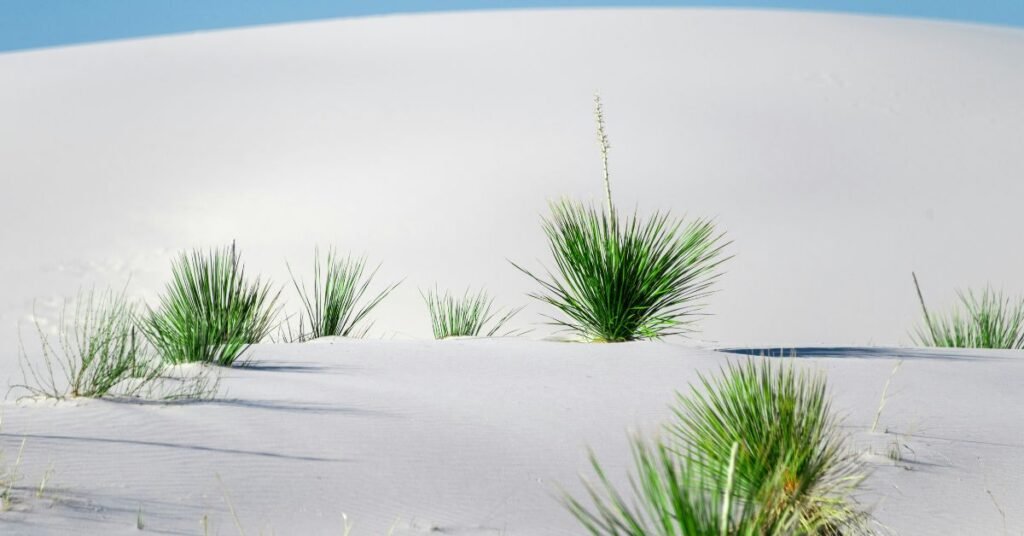The Yucca Plant is one of the most striking and easy-to-grow plants for both indoor and outdoor spaces. Known for its sword-shaped leaves, tall flower spikes, and desert-like resilience, the Yucca is loved by gardeners worldwide. Its bold architectural form and low-maintenance nature make it perfect for homes, offices, and landscapes that need a touch of elegance with minimal effort.
This article explores everything you need to know about the Yucca Plant, including its types, growth habits, ideal conditions, and care tips to keep it thriving all year round.
Understanding the Yucca Plant
The Yucca belongs to the Asparagaceae family and is native to the hot, arid regions of North and Central America. It is a perennial shrub or small tree known for its long, pointed leaves and towering clusters of white flowers.
Yucca plants can adapt to both indoor and outdoor environments. Outdoors, they are grown as landscape ornamentals and drought-tolerant garden plants. Indoors, they serve as air-purifying houseplants, adding a modern desert vibe to interior décor.
Key Characteristics of the Yucca Plant
Appearance
Yucca plants have stiff, sword-like leaves that grow in a rosette pattern. The leaves are usually green, bluish-green, or sometimes variegated with yellow edges.
Flowers
During summer, mature yuccas produce tall flower stalks with clusters of creamy-white, bell-shaped flowers. These blooms add a beautiful contrast against the plant’s sharp foliage.
Growth Habit
Depending on the species, Yuccas can grow as low shrubs or tall trees, reaching heights of 2 to 30 feet. Indoor varieties remain smaller and more compact.
Lifespan
Yucca plants are long-lived and can survive for many years, even decades, with proper care.
Types of Yucca Plants
There are over 40 known species of Yucca, but a few are especially popular for home and garden use.
1. Yucca Elephantipes (Spineless Yucca)
- Ideal for indoor spaces
- Has smooth, non-sharp leaves
- Can grow up to 10 feet tall indoors
- Known for its modern, tree-like look
2. Yucca Filamentosa (Adam’s Needle)
- Common in outdoor gardens
- Has stiff, sharp leaves with white filaments
- Produces tall flower spikes with white blooms
3. Yucca Gloriosa (Spanish Dagger)
- Hardy outdoor plant
- Produces large clusters of white flowers
- Prefers full sunlight and well-draining soil
4. Yucca Aloifolia (Spanish Bayonet)
- Sharp, pointed leaves resembling a bayonet
- Great for desert landscapes
- Can tolerate harsh conditions
- 5. Yucca Brevifolia (Joshua Tree)
- Famous desert species native to the Mojave Desert
- Can grow up to 40 feet tall in its natural habitat
- Symbol of endurance and beauty
Ideal Growing Conditions for Yucca
The Yucca Plant is incredibly adaptable but thrives best under certain environmental conditions.
Light Requirements
- Prefers bright, indirect sunlight indoors
- Outdoors, it loves full sun exposure
- Too little light can cause slow growth and pale leaves
Temperature
- Thrives between 18°C to 27°C (65°F to 80°F)
- Can tolerate cooler temperatures but not frost for long periods
- Protect from cold drafts indoors
Watering
- Water sparingly — Yucca is drought-tolerant
- Let the top 2 inches of soil dry before watering again
- Overwatering can lead to root rot
Soil Type
- Prefers sandy, well-draining soil
- A cactus or succulent mix works perfectly
- Avoid heavy clay soil
Humidity
- Yucca prefers dry air
- No need for misting — it adapts well to normal room humidity
How to Plant and Propagate Yucca
Planting
- Choose a pot with drainage holes.
- Use a sandy, well-draining soil mix.
- Place the plant where it receives bright light.
- Water lightly after planting.
Propagation Methods
Yucca can be propagated through:
1. Stem Cuttings
- Cut a section of stem about 8–10 inches long.
- Allow it to dry for a few days.
- Plant it in well-draining soil.
- Water lightly until roots form.
2. Offshoots (Pups)
- Mature Yucca plants produce baby plants at the base.
- Gently separate them and plant in a new pot.
- Keep in bright, indirect light until established.
3. Seeds
- Seeds can be sown in sandy soil but require patience, as germination is slow.
Yucca Plant Care Tips
1. Light Balance
If kept indoors, rotate the plant occasionally so all sides receive sunlight. This prevents uneven growth.
2. Water Sparingly
Yucca is highly drought-tolerant. Too much water will cause yellow leaves or mushy stems.
3. Fertilization
Feed once a month during the growing season (spring and summer) using a balanced liquid fertilizer diluted to half strength.
4. Pruning
Prune dead or damaged leaves at the base using clean shears. For tall plants, you can cut the top stem to encourage branching.
5. Repotting
Repot every 2–3 years or when the plant outgrows its container. Choose a slightly larger pot each time.
Common Problems and Solutions
Even though Yucca is a hardy plant, a few issues can arise if not properly cared for.
Yellow Leaves
Cause: Overwatering or poor drainage
Solution: Allow soil to dry before watering again and ensure good drainage.
Pests (Mealybugs, Spider Mites)
Cause: Dry air or infrequent cleaning
Solution: Wipe leaves with a damp cloth and use organic neem oil spray.
Soft or Mushy Stems
Cause: Root rot from overwatering
Solution: Remove affected parts and replant in dry, sandy soil.
Brown Leaf Tips
Cause: Too much direct sunlight or lack of humidity
Solution: Move to a spot with filtered sunlight and avoid excessive heat exposure.
Benefits of the Yucca Plant
The Yucca Plant offers both aesthetic and practical benefits:
1. Air Purification
Yucca removes toxins such as benzene and formaldehyde, improving indoor air quality.
2. Low Maintenance
Perfect for beginners — it needs minimal water, little fertilization, and occasional pruning.
3. Versatility
Can thrive indoors or outdoors, in pots or directly in the ground.
4. Symbolism
Yucca represents protection, resilience, and purity, often associated with endurance and new beginnings.
5. Landscape Design
Its bold shape makes it an excellent focal point in rock gardens, patios, or modern minimalist designs.
Indoor vs Outdoor Yucca Care
Indoor Yucca:
- Needs bright, indirect sunlight
- Water once every 10–14 days
- Use lightweight, sandy soil
Outdoor Yucca:
- Full sun exposure
- Water once a week during dry spells
- Mulch around the base to retain moisture
Seasonal Care Routine
Spring
- Begin light fertilization
- Check for new growth and prune dead leaves
Summer
- Regular watering (only when soil dries out)
- Watch for pests
Autumn
- Reduce watering gradually
- Avoid fertilization
Winter
- Keep indoors or protect from frost
- Minimal watering — just enough to prevent drying out
Designing with Yucca Plants
Yucca plants bring a sculptural and bold aesthetic to any space.
Outdoor Ideas
- Combine with succulents and cacti for a desert-style garden.
- Use as borders or focal points in dry landscapes.
- Pair with rocks, gravel, and minimalist décor.
Indoor Ideas
- Place near large windows or entryways.
- Use decorative ceramic or clay pots for a modern touch.
- Combine with other tropical plants for a natural indoor oasis.
Fun Facts About Yucca
- The state flower of New Mexico (USA) is the Yucca.
- Native Americans used Yucca leaves to make rope, baskets, and soap.
- Yucca roots contain natural saponins, which create foam and were used as natural shampoo.
- Some species are pollinated exclusively by the Yucca moth, showing a rare example of plant-insect cooperation.
Final Thoughts
The Yucca Plant is more than just a decorative plant — it’s a symbol of endurance, purity, and natural strength. Its minimal care requirements make it ideal for beginners, while its bold form adds personality to any space.
Whether you keep it in your living room, patio, or garden, Yucca will reward you with beauty, resilience, and years of effortless growth.
If you’re looking for a tough yet graceful plant that thrives with minimal care, the Yucca Plant is the perfect choice to bring a desert charm and calm energy into your home or garden.

